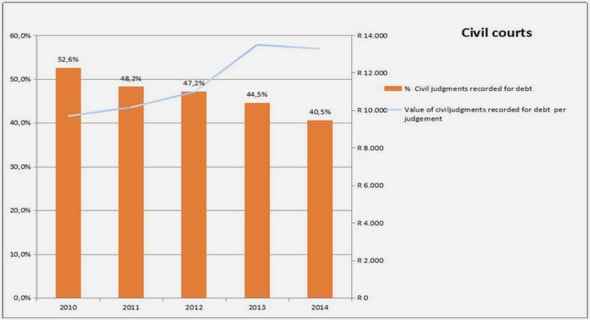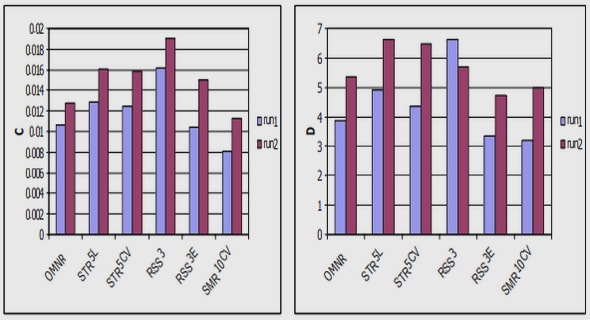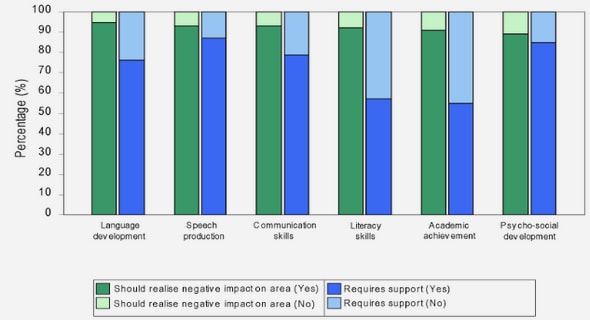Get Complete Project Material File(s) Now! »
Transversality implies absolute continuity
In the late 1930’s Erdös considered the random series Yλ= ±λN, 0<λ<1, N≥1 where the signs are chosen independently with probability 1/2. A long standing conjecture by Erdös was that, for Lebesgue almost every λ ∈ [1/2, 1), the distribution νλ of Yλ is absolutely continuous with respect to Lebesgue measure m on R. This conjecture was finally proved to be true by Solomyak [So] in 1995 using Fourier transform methods. One year later in 1996, Peres and Solomyak [PS] gave a simpler proof of this result by using differentiation of measures and by taking into account a geometric transversality property of Yλ. We will roughly explain this transversality property of Yλ and how it can be used to prove absolute continuity.
Let Ω = {−1, 1}N be the sequence space equipped with the product topology and µ the Bernoulli measure on Ω with the weights (1/2, 1/2). For ω ∈ Ω, we set Yλ(ω) = ! ωNλN, (1.5) N≥1 where ωN denotes the n-th coordinate of the element ω. Clearly, νλ is the distribution of Yλ : Ω → R. In [PS] it is shown that there exists a constant C > 0 such that for any two different elements ω and ω′ in Ω the following holds. If the curves λ Yλ(ω) and λ Yλ(ω′), λ ∈ [2−1, 2−2/3], intersect each other, then the absolute value of the slope of the curve λYλ(ω) −Yλ(ω′) close to the line [2−1, 2−2/3] ×{0} is greater than C λK , where k = MAX{k ≥ 1 ; ωL = ωL′, 1 ≤ l < k} (see Figure 1.1). This transversality property causes that the curves Yλ(ω), ω ∈ Ω, cannot cluster together too much in the strip [2−1, 2−2/3 ] × [−(1 − 2−2/3 )−1, (1 − 2−2/3 )−1]. In other words, if ν is the distribution: ν (E) = (m × µ) »#(λ, ω) ∈ [2−1, 2−2/3] × Ω ; Yλ(ω) ∈ E$%, then, by the transversality property of the curves on which ν is sup-ported, ν should have some smoothness or uniformity in the vertical direction and, thus, the measure ν should be absolutely continuous with respect to Lebesgue measure on R2 , which then implies that νλ is abso-lutely continuous for a.e. λ. In fact, having verified the transversality property, this absolute continuity can be proved by a simple argument using differentiation of measures. Peres and Solomyak claimed that their simplified proof in [PS] would be better suited to analyze more general random power series. In Paper C we have shown that, indeed, the approach of Peres and Solomyak does apply to certain variants of the original problem —namely, when the λN are replaced by λ for certain well-behaved functions ϕ : N → R. In the light of the tremendous amount of atten-tion the ±λN problems have received and continuous to receive, it is very natural to explore variants such as the ones proposed by Paper C.
To conclude this section, we would like to mention a recent result by Tsujii [Ts] already referred to in Section 1.1. In [Ts], Tsujii applies in an ingenious way the idea in Peres and Solomyak’s paper, that geometric transversality condition implies absolute continuity, to par-tially hyperbolic surface endomorphisms F : M → M , where M is, say, the two-dimensional torus T2 = R2/Z2. We call µ a physical measure for F if the set of points x ∈ M such that
1 N−1 WEAK-∗ µ,as n → ∞,
δF I (X) −→
n I=0
has positive Lebesgue measure. (In the terms of Paper D, one could say that µ is a physical measure if the set of points x ∈ M which are typical for µ has positive Lebesgue measure.) In [Ts] it is shown that, gener-ically, such a partially hyperbolic surface endomorphism has a finite number of ergodic physical measures, whose basins cover Lebesgue a.e. point of M . Furthermore — here appears essentially the idea in [PS].
— these physical measures are absolutely continuous w.r.t. Lebesgue measure on M if the sum of their Lyapunov exponents is positive. This is a true novelty since, usually, absolute continuity is a result of expan-sion in all directions. To obtain absolute continuity in the case when the central Lyapunov exponent is zero or even negative, Tsujii makes use of a similar geometric transversality property as in [PS], which is generically satisfied in the space of surface endomorphisms. More pre-cisely, the intuitive picture is the following. Let F : M → M be a partially hyperbolic surface endomorphism and ν an ergodic physical measure with central Lyapunov exponent equal to zero or sufficiently close to zero (it might be negative). It is shown, that, due to the dominating expansion in the unstable directions EU , ν is attained as a weak-∗ limit point of the sequence 1 N−1 −I νγ◦F , as n → ∞, n I=0 where νγ is a smooth measure on a curve segment γ of an unstable manifold. Zooming in on a small neighborhood of a point in the support of ν, the image F N(γ) should roughly be comparable to the right figure in Figure 1.1. The curves in this neighborhood would not concentrate in the central direction strongly, as the central Lyapunov exponent is nearly neutral (almost everywhere w.r.t. ν). By a certain control of the angles between intersecting curves in F N (γ) — this is generically provided by the transversality property — Tsujii deduces that in fact the measure ν is absolutely continuous.
Heuristically, regarding the Bernoulli convolutions considered in [PS], the numbers log 2−1 and log λ−1 correspond to the Lyapunov ex-ponents in [Ts], where log 2−1 corresponds to the central Lyapunov exponent (the 2 comes from the distribution of µ). Their sum is pos-itive for λ > 2−1, in which case one has indeed almost sure absolute continuity. On the other hand, for λ < 2−1, νλ is singular as it is mentioned in Paper C.
Absolutely continuous limit distributions of sums of point measures
The results in Papers D and E are essentially inspired by the last chapter, Chapter III, of Benedicks and Carleson’s paper [BC1] on the quadratic map fA(x) = 1 − ax2, x ∈ (−1, 1), where they prove that for Lebesgue almost every parameter value a in a positive Lebesgue measure set Δ∞ ⊂ (1, 2), constructed in the previous two chapters in [BC1], the map fA admits an a.c.i.p. µA. More precisely, in Chapters I and II in [BC1] they construct in an inductive way a positive Lebesgue measure Cantor set Δ∞ of a-values such that the associated maps fA have certain expansion properties along the forward orbit of the critical point 0. An important ingredient of this construction is the fact that, for j ≥ 1, the a-derivative ∂A fAJ (1) and the x-derivative ∂X fAJ (1) are comparable if a ∈ Δ∞. In Chapter III these expansion properties in the a-direction are then used to show that for Lebesgue a.e. parameters a ∈ Δ∞ a limit distribution µA of the forward orbit of the critical point exists and is absolutely continuous w.r.t. Lebesgue measure. Even if the techniques in Chapter III of [BC1] turn out to be very powerful, they have, to the best of the authors knowledge, not been used in other contexts than the quadratic maps. Papers D and E provide us with several non-trivial, elementary, and important examples where these techniques can be applied.
In the remaining part of this section we will present the main tech-nical ingredient of the result in Chapter III in [BC1] — and as well of the results in Papers D and E — by showing for the doubling map T (X) = 2X MOD 1, X ∈ [0, 1], the well-known fact that for Lebesgue a.e. point X ∈ [0, 1] the weak-∗ limit of the sequence !j=1 δT j (x) (1.6) N exists and coincides with the Lebesgue measure M on [0, 1]. This exam-ple provided by the doubling map can serve as a toy model for Paper D as well as for Paper E (cf. summaries of Papers D and E below). The Lebesgue measure M is the unique (and hence ergodic) a.c.i.p. for the map T . Thus, the fact we are going to show with the techniques used in [BC1] follows also straightforward from Birkhoff ’s ergodic theorem. Now, let B := « (X−R,X+R)∩[0,1] ; X ∈ Q,R ∈ Q+#, and for each B ∈ B consider the function Fn(X) = !j=1 χB (T j (X)), N ≥ 1,X ∈ [0,1], which counts the average number of visits to the interval B during the first N iterations of X. The main observation is summarized in the following lemma. Its proof is elementary (see, e.g., Lemma A.1 in Paper E).
LEMMA 1.3.1. Let B ∈ B and assume that there are positive constants K and C such that for all H ≥ 1 there is an integer Nh,B such that $ Fn(X)hDX ≤ K (C |B|)h, (1.7) [0,1] whenever n ≥ nh,B . If the sequence nh,B can be chosen to grow at most exponentially in h, then it follows that n→∞ Fn(x) ≤ C |B|, (1.8) LIM for Lebesgue a.e. x ∈ [0, 1].
If (1.8) holds for all B ∈ B, then it follows, by standard measure theory, that for a.e. x ∈ [0, 1] every measure µx obtained as a weak-∗ limit point of δT j (x) j=1 has a density, which is bounded above by C and, in particular, µx is absolutely continuous. Note that, by construction, µx is an invariant probability measure for T . Since the Lebesgue measure m is the unique a.c.i.p. for T , it follows that µx in fact coincides with m and that the weak-∗ limit of (1.6) exists. Thus, we only have to show that for each B ∈ B inequality (1.7) is satisfied where the sequence nh,B grows at most exponentially in h. We write Fn(x)hdx = 1 χB (T j1 (x)) • • • χB (T jh (x))dx. (1.9) nh [0,1] 1≤j1 ,…,jh≤n [0,1] Assume that we have proven the following proposition.
Proposition 1.3.2. For all B ∈ B and h ≥ 1 there is an integer nh,B , growing for fixed B at most exponentially in h, such that, for all n ≥ nh,B and for all integer h-tuples (j1, …, jh) with 1 ≤ j1 < j2 < … < jh ≤ n and jl − jl−1 ≥ √n, l = 2, …, h, we have [0,1] χB (T j1 (x)) • • • χB (T jh (x))dx ≤ (2|B|)h. (1.10).
Remark 1.3.3. As we are going to see in the proof of this proposition, we could state it in a stronger version. More precisely, we could drop the dependence of nh,B on h and, hence, it would be enough to require that the gaps between two consecutive jl ’s are larger than some constant only dependent on B. This is due to the very special properties of the doubling map. However, we are not able to prove such a stronger version in the cases considered in Papers D and E. Since we want to refer to such a toy model as provided by this example with the doubling map, we stated Proposition 1.3.2 in this weaker form.
From a probabilistic point of view, Proposition 1.3.2 says that if the distances between the jl ’s are sufficiently large, then the functions χB (TBjL (x))’s can be seen as independent random variables. In fact, since the doubling map with the invariant measure m is exact and, hence, mixing of all degrees, the integral in (1.10) converges to |B|h as n tends to infinity (instead of 2 in the right hand side of (1.10), we could take any real number strictly greater than 1). Note that, for h ≥ 2, the number of h-tuples (j1, …, jh) in (1.9) for which mink=l |jk − jl | < √n is bounded by 2h2nh−1/2. Hence, by Proposition 1.3.2, we obtain, for h ≥ 1, 2h2 Fn(x)hdx ≤ (2|B|)h + √ ≤ 2(2|B|)h, if n ≥ max « nh,B , # (2|B|)h $ % .
Since both terms in this lower bound for n grow at most exponentially in h, this concludes the proof of (1.7).
To conclude this section we prove Proposition 1.3.2.
PROOF. Set√τB = log(2/|B|)/ log 2, and let nh,B (= nB ) be an integer such that nh,B ≥ τB . By Pj , j ≥ 1, we denote the open intervals of monotonicity for T j : [0, 1] → [0, 1], i.e. Pj = {(k/2j , (k + 1)/2j ) ; 0 ≤ k < 2j }. We set P0 = (0, 1) and if Ω is a subset of monotonicity intervals in Pj , j ≥ 0, then we write Pj+l |Ω, l ≥ 0, for the intervals in Pj+l, which are also contained in an interval of Ω. Set Ω0 = (0, 1) and, for 1 ≤ l ≤ h, we define Ωl = {ω ∈ PjL +τB |Ωl−1 ; T jL (ω) ∩ B = ∅}.
Observe that the set we are interested in, i.e. the set {x ∈ [0, 1] ; T jL (x) ∈ B, 1 ≤ l ≤ h} is contained in Ωh (disregarding a finite number of points). If n ≥ nh,B , then we have jl −jl−1 ≥ τB , 2 ≤ l ≤ h, and we obtain, by the definitions of τB and Ωl , 1 ≤ l ≤ h, Ωl ⊂ {x ∈ Ωl−1 ; T jL (x) ∈ 2B}, where 2B denotes the interval twice as long as B and having the same midpoint as B. Thus, by the piecewise linearity of T jL −jL−1 , 1 ≤ l ≤ h (where we set j0 = 0), we get |Ωl | ≤ 2|B||Ωl−1|, (1.11) which implies |Ωh| ≤ (2|B|)h|Ω0 | = (2|B|)h. This concludes the proof of Proposition 1.3.2.
Table of contents :
I Introduction and summary
1 Introduction
1.1 Viana maps
1.2 Transversality implies absolute continuity
1.3 Absolutely continuous limit distributions of sums of point measures
2 Summary
2.1 Overview of Paper A – Non-continuous weakly expanding skew-products of quadratic maps with two positive Lyapunov exponents
2.2 Overview of Paper B – Positive Lyapunov exponents for quadratic skew-products over a Misiurewicz-Thurston map
2.3 Overview of Paper C – Almost sure absolute continuity of Bernoulli convolutions
2.4 Overview of Paper D – Typical points for one-parameter families of piecewise expanding maps of the interval
2.5 Overview of Paper E – Almost sure equidistribution in expansive families
Bibliography
II Scientific Papers
Paper A
Non-continuous weakly expanding skew-products of quadratic maps with two positive Lyapunov exponents
Ergodic Theory Dynam. Systems 28 (2008), no. 1, 245–266.
Paper B
Positive Lyapunov exponents for quadratic skew-products over a Misiurewicz-Thurston map
Nonlinearity 22 (2009), 2681–2695.
Paper C
Almost sure absolute continuity of Bernoulli convolutions (joint with M. Björklund)
Ann. Inst. H. Poincaré Probab. Statist., to appear.
Paper D
Typical points for one-parameter families of piecewise expanding maps of the interval
Paper E
Almost sure equidistribution in expansive families (joint with M. Björklund)
Indag. Math., to appear.


